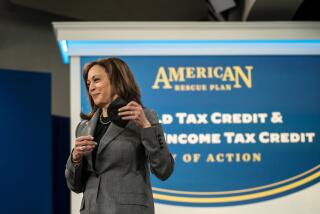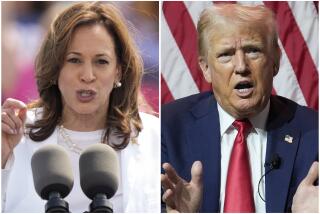Talk of Flat-Tax Plans Overlooks Burdens Placed on Consumers
- Share via
Many have pointed out that the flat tax now so much in the news entails major tax savings for the rich and lesser savings or increased taxes for others. Almost all, however, have failed to note that the shift is much greater than individual income tax tables indicate.
What is overlooked is that the flat-tax proposals compensate for reductions in individual income taxes on the wealthy with business-tax increases. These levies, as touted by flat-tax proponents, are a tax on consumption. Business will pass them on, like a sales tax, to consumers. And they form a particularly harsh burden on low- and middle-income taxpayers who spend almost all of their income on consumption. The rich, who consume much smaller portions of their income and spend more abroad, would be far less affected.
In addition, the base for business taxation would be vastly expanded even though firms would be subject to the single new flat rate that is considerably lower than the current rate. Business would generally no longer have deductions for employer contributions for Social Security, state and local taxes, interest payments, and medical insurance and other “fringe benefits.”
A few numbers make that clear. The flax tax proposed by Rep. Dick Armey (R-Texas) would require a rate of nearly 23%--not the 20% or ultimate 17% he has put forth--in order to preserve revenue neutrality consistent with the calculations of Professors Robert Hall and Alvin Rabushka, the fathers of Armey’s current flat tax plan. But because of the elimination of deductions, business taxes would have increased by some $200 billion in 1993--from $237 billion under current law to $435 billion.
It is this $200-billion increase in business taxes that permits a corresponding reduction in individual taxes. It is thus possible to tell voters that the flat tax will save taxes for most of them. But what it saves them in income taxes, it takes away in the increased taxes passed on to them as consumers.
Thus, Armey’s original flat-tax proposal would not tax the wages of a family of four earning $34,700. But those in the $30,000-$40,000 income class would pay almost 11% of their income in this business-sales tax. They would pay these taxes at the checkout counter instead of in withholding by their employers, but the taxes would be no less real.
We get some rather dramatic results if we add the Armey wage and business taxes to get the total federal taxes (not including Social Security and Medicare taxes) and then compare them with current tax burdens.
Those in the $100,000-$200,000 class would find their total taxes reduced from 18.7% of income to 16.1%. Those making $200,000 a year or more would find their taxes cut virtually in half from 24.4% to 12.7% of income. And every other income group up to $100,000 would have their taxes increased.
The version of the flat tax put forth by Republican presidential candidate Steve Forbes is less objectionable to average taxpayers simply because it makes no pretense to revenue neutrality. With personal exemptions for a family of four coming to $36,000, Forbes offers a “flat” rate of 17%, almost 6 percentage points less than what was necessary to prevent a net loss of revenues for the Armey brackets.
It would effectively cut current income taxes by more than 25%. The very rich would gain enormously. Those with $200,000 or more in total income would find their bite from income and business taxes falling from 24.4% to 9.4%. And most others, except some of those too poor to pay income taxes under current law, would also gain, though not nearly as much. But by “static” scoring (meaning ignoring any favorable effects on the economy), the Forbes flat tax would have added some $160 billion to the deficit in 1993.
Of course, flat-tax proponents argue with some justification that static scoring is inappropriate. A prodigious tax cut of that kind would stimulate the economy, though more because it would increase purchasing power than because of so-called “supply-side” benefits. But few admit they still believe in the old “Laffer Curve,” named after economist Arthur Laffer and used by those who contended that lowering tax rates would actually raise government revenues. That claim was discredited in the 1980s by the huge budget deficits that followed when President Reagan cut tax rates at the same time he dramatically increased military spending. Clearly, a $160-billion tax cut would add a great amount to the deficit by anybody’s reasonable scoring.
Contrary to current hyperbole about budget-balancing, deficits may not be all bad. But increasing them by concentrating tax cuts on the rich while imposing new curbs on spending for medical care, education, crime prevention and welfare hardly seems to be ideal public policy. While there is certainly great appeal in trying to get rid of a loophole-ridden tax system, the elimination of taxes on capital income--interest, dividends and capitals gains--received overwhelmingly by the rich may be introducing the biggest loophole of all.
Any serious consideration of the flat taxes currently in the political arena must begin with some honesty and openness in packaging. Unless they make large cuts in Treasury revenues, what reductions there are in individual taxes are taken away in the new consumer taxes.
Those taxes fall overwhelmingly on the great majority of Americans. They hit tens of millions of the poor who pay no income taxes at all now. And they hit the vast “middle class” that the flat tax is professed to help.
More to Read
Inside the business of entertainment
The Wide Shot brings you news, analysis and insights on everything from streaming wars to production — and what it all means for the future.
You may occasionally receive promotional content from the Los Angeles Times.










